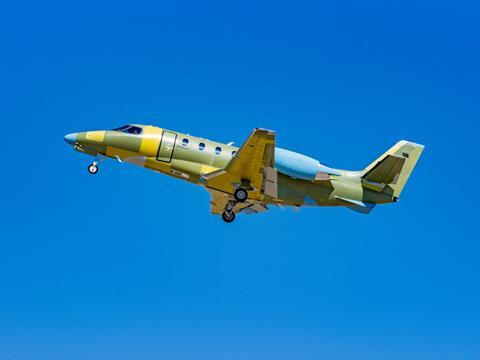The first certification-conforming production airframe of Textron Aviation’s Cessna Citation Ascend has completed its maiden flight.
The Wichita-based company said on 13 June that the initial flight of the second jet – after a prototype flew in 2023 – lasted 1hr 24min, and reached an altitude of 13,500ft with a maximum speed of 308kt (570km/h). The company says the aircraft will be used for systems testing, including propulsion, human factors, environmental control and avionics.
Textron Aviation is working toward securing an amended type certificate for the Ascend. The type, which was unveiled at the EBACE show in Geneva last year, is still on track to enter service in 2025.

“Today’s successful flight of the second Citation Ascend test article marks another achievement for the programme, and that’s a testament to the many great employees involved with this project,” Chris Hearne, Textron Aviation’s senior vice-president of engineering, says. “The aircraft has continued to perform well through the phases of testing, and I continue to be confident in the programme’s momentum and in our skilled team members who make it possible.”
The airframe’s flight test programme is expected to complete certification testing with the prototype, and the new airframe, which the company has dubbed “P1”. To date, the programme has accumulated more than 400 flight hours, Textron says.
The Citation Ascend is an updated variant of the Cessna Citation Excel. The company last updated the Excel in 2021 when it rolled out the XLS Gen2 variant, which included several cabin updates.
In tandem with the reveal of Ascend in May 2023, engine supplier Pratt & Whitney Canada disclosed the development of a new version of the PW545 turbofan – the PW545D – which will power the Ascend.
Key updates on the Ascend are Garmin’s G5000 avionics suite – replacing its predecessor’s Collins Aerospace Pro Line 21 cockpit – and the improved engines, plus a flat-floor cabin and larger windows.
Performance targets for the Ascend include range at high-speed cruise and with four passengers of 1,900nm (3,520km), and maximum cruise speed of 441kt – similar specifications to the XLS Gen2. It will accommodate nine passengers in a standard configuration but will be capable of carrying up to 12.
Design improvements will allow Ascend “to carry a high combination of payload and fuel load, while retaining access to short runways”, the company said at the time. Its maximum take-off weight will be 20,500lb (9,300kg) – 170lb more than the XLS Gen2.


























